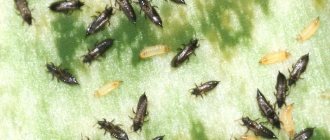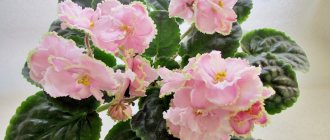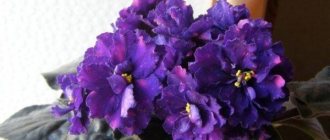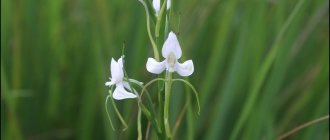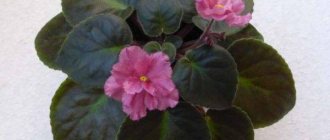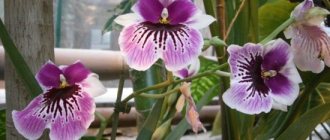There are legends around this violet and almost detective investigations are carried out; this is the Charming Eyes variety, at least the variety that is now popular under this name .
The appearance of this Saintpaulia is attractive, and for many collectors
it is important to know:
- Origin of the variety;
- Or the presenting breeder.
The charming eyes were created by a famous person among flower growers, the author of many classic and retro varieties of violets - B. Makuni . But the important question is that Saintpaulia, popular today, bears this name with a big question mark.
In the article you will see a photo and description of the variety.
Violet Charming eyes (B. Makuni)
Violets The charming eyes of Makuni have the following description (written during the author’s lifetime):
- Flower : Single;
- Star shaped;
- The edge of the petals is slightly wavy;
- The color is snow-white with a lilac spot in the center.
On the Internet, during the investigation, they found a clipping from an old newspaper, with an article by the Makuni spouses themselves, in which a photo of this variety was inserted . The Makuni variety is considered lost, so another violet is called by this name, and is often attributed to this breeder.
Found newspaper.
The variety belongs to the genus of hybrid Saintpaulias, the Gesneriev family. Most flower growers agree that this variety was bred from an industrial variety , but the history of its origin and author are unknown.
Saintpaulia rosette:
- Flat;
- Medium size;
- Neat;
- About 16 cm in diameter.
Violet leaf:
- Round;
- Finely toothed along the edge, on a short stalk.
The variety has an unusual leaf color.
Sheet color:
- Motley;
- Mosaic;
- Bright green with white.
Important! Variegation is more characteristic of young rosettes, and disappears in most individuals as they grow older.
Flowers of the variety in question:
- Quite large;
- Simple stars;
- Slightly bell-like;
- About 5 cm in diameter.
The color of the flowers is complex:
- The main color is considered blue and white;
- The edges of the flower are darker, bluer;
- And in the center there is an even darker peephole.
Depending on the conditions of detention and age, it may be more or less variegated. And the color of the flowers changes from lighter in cool weather to more saturated in hot weather. Sometimes the flowers can be blue with a blue edge and an even darker eye.
“Soulful violets,” or details of a visit to MakuniI don’t know why, but I put off the meeting for a very long time, about three months... Finally, I gathered my courage and called. It turned out to be very easy to arrange to see the collection (and, of course, purchase the cuttings you liked!), the only thing Boris Mikhailovich asks is to call on the day of arrival or the evening before. The three of us went - me and my two equally passionate friends about violets. Boris Mikhailovich greeted us very warmly and immediately led us into a large room, complaining about the lack of time and the spartan conditions of keeping his collection. Entering the apartment, you find yourself as if in another dimension, an island, cut off from the rest of the world... Everything bears the imprint of the personality of the owners - Boris Mikhailovich himself and his son Denis, an amazing, creative nature. Denis is an artist, extremely talented and passionate, all his paintings contain a piece of his soul... But this is the topic of a separate story... The collection is contained on three large shelves with fluorescent lamps, as well as two window shelves of the original design - violets standing on shelves like as if they were “hovering” in the air. We arrived, of course, with our list of varieties and the author’s book, from which most of this list was taken. But everything turned out to be completely different, and from simply reading out the list, we very quickly moved on to discussing each variety separately. It turned out that the author calls 'Ataman', which I searched for a long time and unsuccessfully, as an unsuccessful variety, since it is prone to fungal diseases and is difficult to grow. As a replacement, the author developed the 'Sorcerer' variety, which he considers more successful - large semi-double dark cherry stars with notched, slightly pointed petals. Boris Mikhailovich also rejected 'Evening Chime' - due to the poor repeatability of the variety's characteristics, 'Magic Snow' (degenerated), 'Starfall' - instead of which they advised (and showed us) 'Magic Night' - a bouquet of fancy dark blue flowers with peas of pink fantasy and explained that the variety is perfectly transmitted and blooms continuously in a “bouquet”. Boris Mikhailovich’s attitude to color and color shades is very interesting - for example, we unsuccessfully tried to find out the color of his new variety 'Graceful Stranger' (2002 variety, as B.M. himself calls it) - and in response we received: “What do you think ? As a result, there were several options depending on the color perception of each: plum, violet, lilac... By the way, we never found out the color of the new variety 'Cat Leopold' (which, as we were informed the day before, “all of Moscow is chasing")... The variety - a riddle, the only thing we managed to find out was about the interesting shape of the flower - a cat's face. The 'Hamster' variety is in the same style - with petals like hamster cheeks... We heard about many varieties for the first time. Moreover, the “names” bear the imprint of the humor of the author and his son, for example, “Blyakha-Fly”, “Honduras”, “Brother-2” (“killer” variety!), “Aunt Asya” from the new “white series”. From the many varieties of the “white series”, Boris Mikhailovich advised choosing... ALL! And when we grow and compare, describe to him in detail the advantages and disadvantages of each variety: 'Narcissus', 'Snow Waltz', 'Blizzard', 'First Date', 'Aunt Asya'... Makuni is very interested in the fate of all his “brainchildren”, and he asks to be sure to report what success (size, color) of the flower, who achieved it. From the “pink” series, the variety ‘Pink Sun’ immediately caught our eye, which is distinguished by very high peduncles, and when the flowers bloom, “the sun rises,” and when they grow to a size of 5-6 cm, “the sun sets.” Although the variety, in the author’s opinion, is not very successful, we liked the special, “beige” shade of the flower (by the way, the beige-peach color “Coffee Aroma” variety was mentioned, which the author “put somewhere”, and now has been trying for a long time and unsuccessfully find). You should also pay attention to other new products in the pink series - 'Pink Light' and 'Pink Salute', which make up a whole range of shades of pink. And, of course, a separate conversation about dark - burgundy and purple varieties. We were advised the varieties 'Dark Prince', 'Panther', 'Brother-2', 'Graceful Stranger'. And, of course, 'Leshy'! The variety is stunningly beautiful, as if it glows from within. Of the blue and lilac varieties, among the best were named 'Blue Treasure', 'Solveig's Song', 'Lilac Excitement', 'Chic Lilac' and the new 'White Night', which has an amazing, two-tone white-blue color and an interesting flower shape (lower the petals are like those of an ordinary “star”, however, they are more rounded, and the upper ones are collected into a kind of “water lily”).
Boris Mikhailovich’s opinions on the following issues are interesting: Earth
— B.M.
recommends making the earthen mixture yourself, bypassing the use of ready-made mixtures; he is wary of “Vermion” (always a different composition!) after the sudden death of a batch of cuttings. As he says, it is difficult to be sure that some “Uncle Kuzya” will not throw a shovel of copper sulfate into the mixture. About the land from the “Field of Miracles” series by B.M. with a sly smile, he advised me to pay attention to the name (the “Fart” company - some will be lucky and some will not) and the emblem (resembling a fig) of the manufacturer. As Boris Mikhailovich said with a laugh, when he was looking for the name of the manufacturer of this mixture, he came across the inscription “made by a Californian earthworm,” which amused him greatly. Fertilizers
- no fertilizers!
Only timely transplantation! Powdery mildew
- a tablespoon of superphosphate per bucket of the mixture - and you will forget about powdery mildew!
Fungus mosquitoes
are the simplest remedy that no one has ever thought of using - plugging in a liquid mosquito fumigator into the outlet (B.M. himself does not have mosquitoes).
Delayed flowering
- according to B.M. often occurs due to the fault of large lower leaves, which during the growth process absorb nitrogen from the soil, which is later released back, which stimulates the growth of violets and prevents flowering. It was recommended to tear off the lower leaves.
They left very impressed - Boris Mikhailovich’s powerful aura, ability to captivate people in conversation, intelligent, penetrating eyes... Such people are like a breath of fresh air in a stuffy city. By the way, on the kitchen rack in a tray for jellied meat, in the same “Spartan” conditions as the rest of the collection, seedlings of new, stunning, “spiritual” violets from Makuni are diligently striving for the light...
© Anna Skvortsova
(Phoenix)
Caring for a plant at home
Suspicions about the industrial origin of the variety are confirmed by the unpretentiousness of the variety . The main points of care are classic for all Saintpaulias.
Conditions of detention
For good growth and development of the outlet, you do not need to create special conditions, just choose a suitable place:
- With bright lighting, without direct sunlight;
- Without drafts and temperature changes (range 18-24° depending on the season);
- Preferably with air humidity of about 60%.
Saintpaulia does not like direct sunlight.
Under such conditions, the outlet will be smooth and neat. Many gardeners recommend not making different temperatures when the season changes, but always maintaining it at 22-24°. Depending on the temperature conditions, the shade of colors may change.
In addition to a well-chosen habitat, it is important to create proper care, which includes interrelated factors:
- Watering – carried out by two main methods:
- Under the leaves or in the tray , water is added in one of two ways, while the frequency of watering and the basic principles are the same. Watering is carried out as the soil dries - about once a week in the summer and a little less often in the winter;
- Wick - water is constantly in a container under the pot and a wick (cord) from the flowerpot is lowered into it through the drainage holes at the bottom.
- Priming – you can simply buy a special substrate for Saintpaulia at a flower shop, but it is not as suitable for violets as one correctly composed at home, and besides, different watering requires different proportions. The main ingredients are:
- Peat, soil, perlite;
Or vermiculite and sphagnum moss, which is replaced with coconut fiber.
- Feeding – the frequency and concentration of mineral fertilizers also depends on the type of irrigation:
- For the classic procedure, the procedure is carried out through watering - approximately once every two weeks in the summer and a little less often in the winter, and the dosage recommended by the manufacturer is halved;
- For the wick version, fertilizers are constantly added to the water, and taking this into account, the concentration should be 7-8 times less than that indicated in the instructions.
For the first type of irrigation, the proportion is 1/1/1/0.3, and for the second - 1/0/1/0.1;
Attention! This variety is unpretentious in care, and even mistakes will not immediately lead to the death of the flower, but will only slightly spoil its appearance.
Reproduction, pruning, rejuvenation
For good development of Saintpaulia, it is necessary to remove damaged areas.
Constantly growing Saintpaulias constantly require pruning for hygiene purposes . To do this, cut:
- Old sheets;
- And faded flower stalks.
In addition, when transplanting, the pruning is made deeper, and the 2-3 lower rows of leaves are removed, and all the material, except the first row, is used further for propagation.
Transplantation is carried out as necessary, and the reason may be:
- Outgrowing the pot - the plant is simply transferred;
- Soil depletion - provided regular feeding is carried out quite rarely, and the earthen ball is completely replaced;
- Deepening - when the bare stem of the rosette rises too high above the pot, after replanting the violet usually remains in its pot, and the soil is replaced (sometimes it is necessary to trim the slightly underground part of the stem);
- Diseases - if Saintpaulia is sick, it should be replanted with a complete replacement of the soil and cleaning of the roots.
Reproduction and rejuvenation are very important aspects in floriculture, which are quite simple for violets. Old rosettes are usually rejuvenated using the method of rooting the apex :
- The growth point with several rows of leaves is cut off;
- Remove 1-2 rows at the bottom;
- Place the stem in water, soil or moss;
- After the roots appear (in water and moss), the rosette is planted back into the ground.
Reproduction is possible by all known methods:
- Rooting a leaf cutting:
- The sheet is taken from row 2-3;
- Rooting is carried out in water, moss or soil;
- In the first two options, they are planted in the ground after the roots or children appear (depending on the preferences of the grower);
- Children are seated as needed.
Most often, violets are propagated by leaves. - Rooting of the peduncle is carried out in the ground, under the film.
- Stepchildren are planted at an independent age (with their own roots), or rooted using one of the methods used for leaves.
Attention! Seeds can still be used for propagation, but this method, even if the variety is self-pollinating, can give many unexpected options, and is therefore usually used for breeding new varieties.
Life phase display
Based on the course of all possible life processes, the variety belongs to the classics of the genus .
Everything happens on time, with the necessary breaks, and the violet does not have to create non-standard microclimate conditions.
Only from time to time certain nuances may arise , which are not particularly difficult to solve.
Specifics of formation in a room collection
The almost problem-free violet is ideal for inclusion in the collections of violet growers with varied experience of communicating with exotic beauties. The variety itself, without outside help, lays out a symmetrical rosette, laying a lot of buds. A flowering cap is obtained during the second or third flowering and is preserved for quite a long time without losing its decorative effect.
A distinctive feature is a certain slowness in preparation for the laying of buds and the flowering process. But this gives some advantage in the duration of flowering: the buds open more slowly, which means they remain fresh longer.
CAREFULLY! As young specimens develop, the rosettes initially have a “liquid” structure, but gradually gain green mass and become denser. In adult violets, it is impossible to notice significant gaps between the leaves. But another negative may arise - the leaf plates willingly hug the flowerpot.
At the beginning of flowering, you can notice the discrepancy between the author’s description of snow-white flowers and the emerging picture - almost all violet growers who have the Tatyana’s Day variety talk about a lilac-bluish tint.
Typically, the tint color colors the corollas at the bud phase or the beginning of opening.
Violet does not require a lot of light; it develops quite harmoniously on the shelves, right down to the lower shelves.
Growth of an adult specimen
Determining the moment when Saintpaulia turns from a baby into an adult plant is quite simple - the sign is the formation of the first flower buds . Most Saintpaulia varieties, including Tatyana's Day, go through the process of maturation according to the standard laws of the genus and in almost the same time.
The duration of growth at this stage of development can only be affected by differences in the methods of producing a baby:
- If you use the leaf method, it will take about eight months for the violet to fully mature;
- If you take stepsons from adult specimens for rooting, the time will be significantly reduced.
Peculiarity of reproduction
To obtain healthy young Saintpaulias, novice flower growers should remember a few fundamental tips from experienced specialists in the field of violet breeding:
- Do not try to propagate violets by seeds - this will certainly lead to the loss of the variety;
- Master and apply carefully vegetative propagation processes:
- Obtaining children from leaf cuttings;
- By planting shoots formed by the violet itself.
- Preserve the varietal qualities of Saintpaulia using the procedure for rejuvenating an adult specimen.
The effect of temperature on buds and flowers
The formation of magnificent, voluminous caps of large flowers is possible only in conditions of maximum comfort for varietal Saintpaulias - this means maintaining the indoor microclimate within the range of +20 + 24°C.
Slightly lower temperatures will not significantly affect the flowering process ; the violet will bloom in due time.
Only the quality of the corollas themselves can suffer, since they will not be able to achieve the greatest decorative effect due to their reduction in size.
IMPORTANT! In hot conditions, the violet will try to push back the flowering phase to a later date; it may open slightly deformed flowers, or skip this flowering altogether.
The structure of peduncle branches
Violet is characterized by the formation, even during the first flowering, of fairly strong peduncles of a shortened structure. Due to this constitution, the peduncles have great endurance and easily support the heavy flower caps in an upright position, preventing them from falling onto the rosette.
Flowering silhouette model
According to the author's description, violet belongs to the group of Saintpaulias , which during the flowering process form lush cap forms from numerous huge buds.
But such beauty appears gradually, the first flowering occurs with the formation of only a few peduncles, which are recommended to be cut off even before the buds begin to open.
This measure helps young Saintpaulia :
- Enough to get stronger;
- And don’t waste extra energy before the next flowering.
Flower lifespan
The slow phases of bud formation and the beginning of flowering lead to long-term preservation of the fresh appearance and decorative outlines of Saintpaulia flower caps. Because of this same feature of the variety, each corolla is able to live a little longer than the flowers on other varietal violets - from one to one and a half months.
Violet blooms for 1.5 months.
Reviews
Valentina Petrovna. “I’ve been collecting Makuni varieties for a long time. I really like the simplicity and at the same time charm of retro Saintpaulia. I bought Charming Eyes, I really liked it, the flowers are beautiful and the rosette itself is very smooth and beautiful. Disappointment only came when I realized that the variety was not quite right. When I accidentally found out that the Makuni variety had been lost, at first I didn’t understand how it was, and when I figured it out, I became upset.
The only joy is the beauty of the bush, which compensates for the bitterness of disappointment, now I’m trying to find a real variety.”
Violet Charming eyes attracts many gardeners.
Veronica Pavlovna. “I bought the variegated baby Charming Eyes, I really liked the pattern on the sheets. When it first bloomed, I was a little surprised by the number of flowers and their size. Very beautiful flowers, both in shape and color. It took her 8 months to reach an adult socket, but I don’t know how old she was when she bought it. The diameter of my rosette is 17 cm, which is very good for wick-irrigated Saintpaulia. The flowers are large, both blooms grow up to 6 cm.”
Features of flowering, growth and reproduction
The variety grows quite quickly, and the first flowering can be expected in 10-11 months. The rosette forms itself, even on the windowsill, and does not require additional lighting. With wick irrigation, the rosette may slightly outgrow its standard dimensions, but the size of the flowers may also increase.
The variety is propagated by all available methods, taking into account the absence of a chimeric pattern on the flowers. But propagation by peduncle or seeds may not transmit the variegation of leaves to the offspring .
The flowering is abundant, in a bouquet, but it can hardly be called a cap, because the flower stalks often fall on the leaves , being quite long and thin. The duration of flowering is very pleasing, each bud lasts from a week to two. Color depends on temperature:
- In hot weather, a darker shade of blue, and almost blue at the edges;
- In cool weather the flowering is light, almost white.
Attention! The size of the flowers is also pleasantly surprising; on a fairly small rosette, they are about 5 cm.
Description of the variety
The violet “Winter Smiles” was obtained by crossing two different varieties of Saintpaulia.
Thanks to this, the flowers of the plant have such a specific color: its flowers are painted in a soft pink shade, and there is a multi-colored “fringe” along the edges.
This, perhaps, is the main difference between the “Winter Smiles” violet and other varieties.
As already mentioned, the violet variety “Winter Smiles” was developed by Boris Makuni . He and his wife devoted most of their lives to these wonderful plants. In total, he bred more than three hundred species of violets, but until the end of his life he considered the “Winter Smiles” violet to be his most important “creation.” For many years, breeders have been striving to preserve this variety unchanged.
Among the main features of the variety are:
Leaves
- Leaf color is pale green.
- The type of foliage is simple.
- The shape of the leaves is heart-shaped, quilted.
- The color of the reverse side of the sheet is pink.
- The edge of the leaf is serrated.
- Variegation – absent.
Flowers
Size – quite large flowers, reaching about 5.5 centimeters in length.- The color of the flower is pink.
- The color is monochromatic.
- The color of the border is green, yellow, purple, red, with characteristic strokes along the edges of the flower, reminiscent of a fringe.
- The number of flowers on a peduncle is on average 3-5.
- Flowering period - does not depend on the time of year or room temperature; Violet blooms quite often and for a long time.
- The flower shape is star-shaped.
- The beginning of flowering is 7-9 months after the cuttings are accepted.
Socket
The rosette of the violet “Winter Smiles” is of the standard, medium-sized rosette type. There are also quite large rosettes - it all depends on the conditions of the plant.
The shape of the rosette is flat and even.
Reproduction
Violet "Winter Smiles" propagates by cuttings and leaves.
Interesting! Description of the variety from the author: “The flowers are double and semi-double, light pink with wine-red strokes on the edges of the petals and an elegant light green fringe. The leaves are green with an olive tint, rounded, slightly elongated. The socket is compact. Strokes on the edges of the petals appear more clearly during the second flowering.” (B.M. Makuni, T.M. Klevenskaya “Saintpaulia”, Moscow, “Astrel”, “AST”, 2001)

